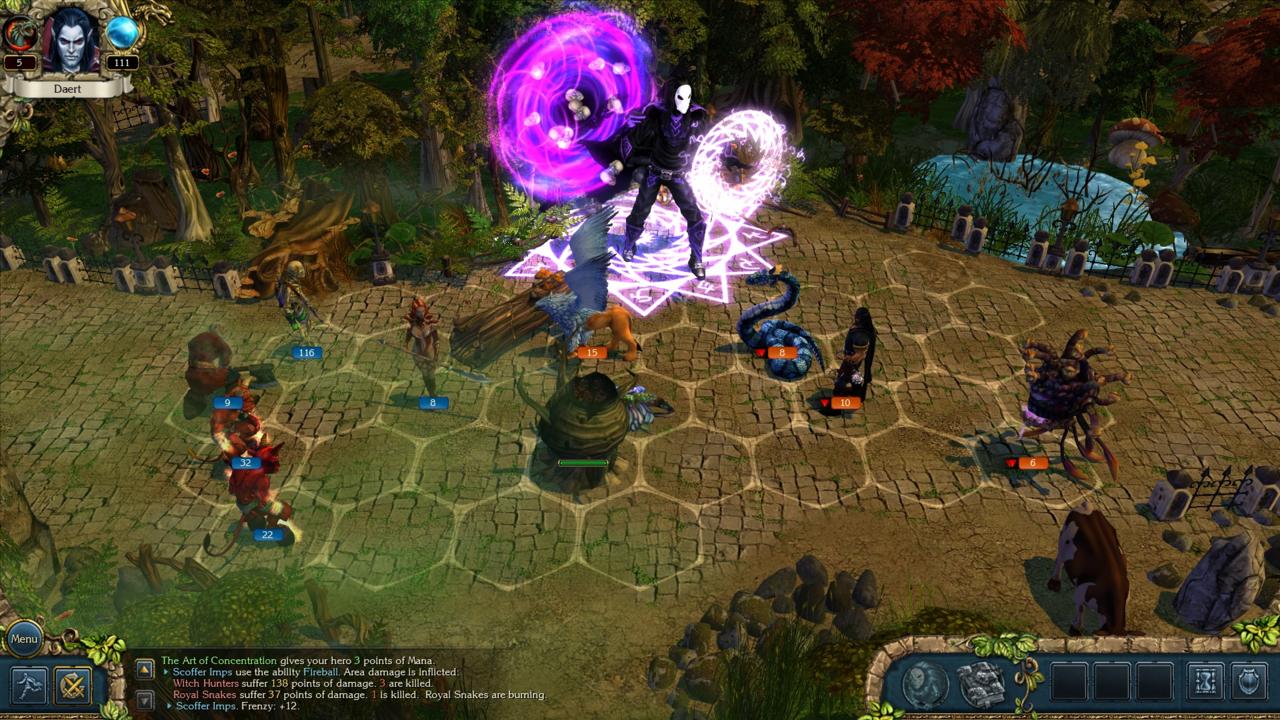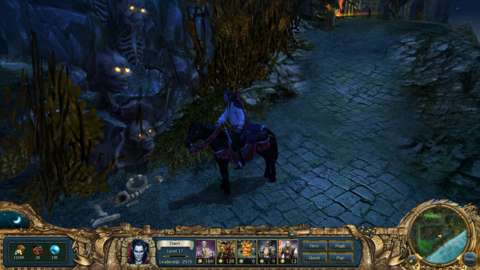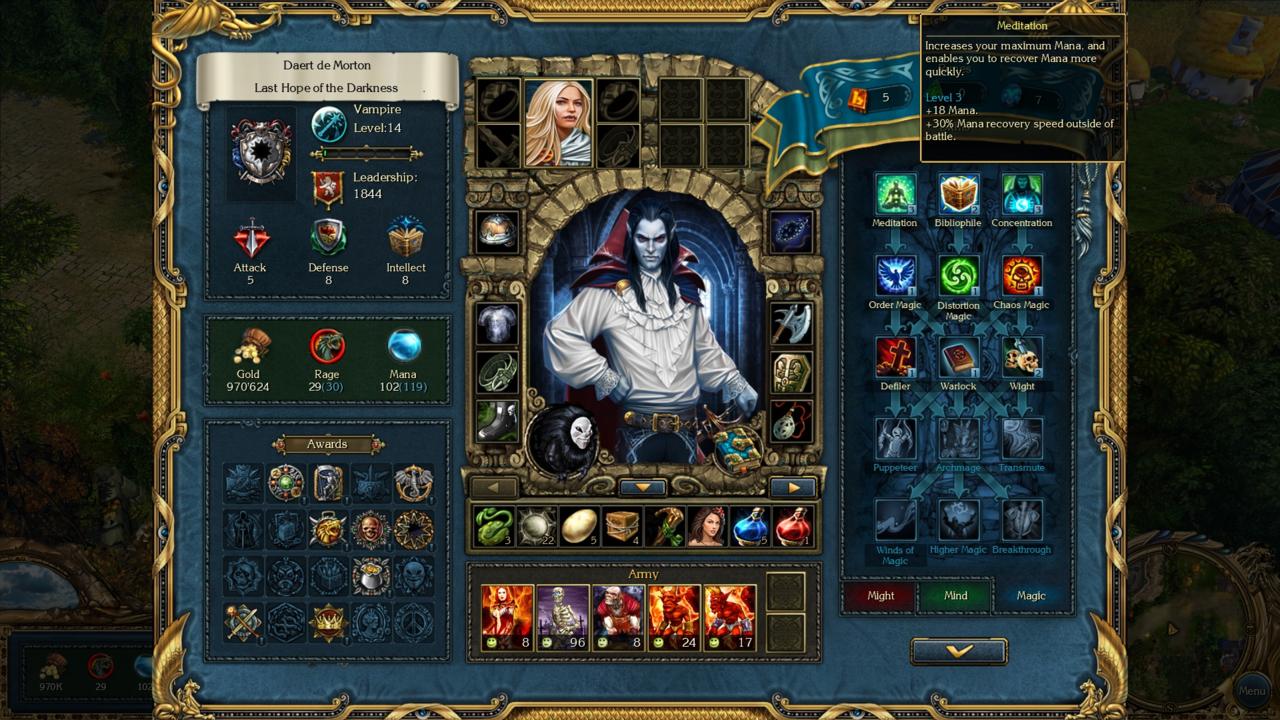Depending on your age, it might be difficult to get John Cafferty & The Beaver Brown Band's "On the Dark Side" out of your head during the entire 30-ish hours it takes to finish King's Bounty: Dark Side. Comparisons to a hit single seem oddly apropos here, given how this turn-based strategizer sticks to your brain. The latest addition to the long-running fantasy franchise is expectedly excellent, thanks to tremendous tactical depth both on the battlefield and with character progression, loads of monsters to command, and a turned-on-its-head story that gives the bad guys a starring role.
The plot is straightforward, although there are significant twists and turns from past King's Bounty games. Here, for the first time, you get to choose your starting race. And those races are a long way from the usual heroic figures you guided before. You choose between a vampire lord, a sultry demoness, and an orc warlord, each of whom has been booted from his or her homeland by white-hatted servants of the light. The writers soft-sell a bit of the evil stuff with explanations about how there always has to be a balance between the light and the dark, and a lot of nudge-nudge, wink-wink humor has been tossed in. (Some translation problems with the text make it hard to take anything too seriously here, in any case.) But the bottom line is that you portray an evil, murderous jerk who turns peasants into zombies for kicks, slaughters enemies for laughs, and seeks out the best people in the land to corrupt for a dark spell that will be used to forge the ultimate anti-good-guy weapon.

This ne'er-do-well saga is lengthy, too. All three protagonists get together early on under the guidance of a cowled evil spirit, who provides tips on how to get rid of the light forces. The game is single-player only, and there are a good 30 or more hours of play here. Difficulty settings are dead-on, too. Easy is exactly what it should be, a cakewalk where you rarely find your armies seriously challenged, and the following levels step things up acceptably until you get to the aptly named "impossible." Since tactical fantasy games like this tend to lean on the tough side of things (I still have nightmares about the Disciples series, and there were excruciating moments in the earlier King's Bounty games as well), it's good to see a broad range of difficulty settings to accommodate all players.
As in earlier games in the series, the story plays out over a number of islands that you gradually explore and conquer for the dark side. All come complete with various maps that feature the usual twisty-turny pathways stocked with loads of goodies like chests of the gold that serves as the sole in-game currency and magical artifacts. The isles are attractive, if a little on the cartoony side, and so packed with detail that you may have to squint to make out various types of objects that you can take or rummage through, like snake eggs, chests, coffins, and funeral urns.
You portray an evil, murderous jerk who turns peasants into zombies for kicks, slaughters enemies for laughs, and seeks out the best people in the land to corrupt.
Quests are as detailed as the landscape, with intricate plot points, plenteous dialogue from non-player characters, and multiple steps that make it seem as if you are playing a proper role-playing game instead of a tactical game with a dash of RPG flavor, as is usual in this genre. Granted, a lot of these assignments are basic "go there, kill them" deals or delivery jobs. But they still got me more involved in the proceedings and made the world more of a living, breathing place than just a place filled with incessant battle arenas. I became attached to my vampire lord alter ego (although I did want to rename him, since Daert isn't exactly an intimidating moniker for a prince of darkness), even when he was vamping princesses and beheading kings. Unfortunately, the game doesn't track nearly enough information about what you're supposed to be doing in the quest logs; Instructions are generally given out during dialogue sequences with NPCs, but they're not stored for easy access later on.
Confusion is not a problem when it comes to battle arenas, which make up the majority of King's Bounty: Dark Side. Even with all of the game's intricacies, the main maps are just places where you scare up battles with patrolling or stationary enemies. As is traditional in the tactical fantasy genre, you serve as the general of a small army of Tolkien refugee troops, slotted into five positions. Your protagonist's leadership score governs how many creatures can be commanded at any given time. This--plus the cost of troops, their availability (which isn't really a concern after the first couple of islands, since you always have ready access to strongholds via teleportation and local shops selling just about every manner of unit you could want), and the tactical concerns governing which sorts of soldiers you want to take into battle against certain enemies--is at the heart of the game.

You have a tremendous number of choices in combat. You're free to pick from all of the units available in the entire series, light or dark. While you may be a bad guy, you have puppet rulers providing access to the good guys (well, corrupted versions of the good guys, like dark paladins and heretic priests). You field armies of zombies and spiky-heeled demon temptresses, giant spiders and snakes, knights and griffons, assassins and pirates, and so forth. You can mix and match, although attack skills, special abilities, and the ability to make ranged assaults are always more important than alignment. I generally went evil whenever I could, both for the novelty of it and due to personal preference. Mostly, I couldn't get enough of the demons, especially the imps with their useful fireballs and clopping kung-fu-kick melee attacks.
Your hero isn't just a figurehead, either. While he doesn't personally enter the fray on the field of battle, he plays a huge role through special abilities and casting spells. Hero progression is a big part of the game as well. Experience points from battles go into leveling up, which increases core abilities like the attack-powering rage and the magic-powering mana. You also earn and collect might, mind, and magic runes that are used to purchase various arcane talents on extensive skill trees. This allows a considerable amount of customization during the campaign. Runes always seem to be in short supply, forcing some tough choices regarding when you're going to spend them on upgrades, and how you might spend them. I went all-in for magic, given how much offensive spells were turning the tide in battles.
Quests are as detailed as the landscape, with intricate plot points, plenteous dialogue from non-player characters, and multiple steps that make it seem as if you are playing a proper role-playing game instead of a tactical game with a dash of RPG flavor.
Allies are also gained over the course of the game. You acquire associates through various evil deeds and by corrupting the innocent. And you also acquire the assistance of a demonic familiar called Blackie (thankfully, this guy you can rename), who can whip out devastating magical attacks during combat based on the amount of rage you currently have in stock. He gains experience along the way as well, opening up new abilities and enhancing current ones. Some are almost overpowering. His orc strike, which drops a magical weapon on the head of a single enemy, does spectacular damage, and the black hole can take out a gang of tightly packed foes. Blackie functions similarly to that of the pet dragon in King's Bounty: Armored Princess, but with added evil.
Vibrant artistry is another part of the appeal. Dark Side is somewhat dated in appearance, and the translation problems give the game some of its budget-game aura, but it has the classic allure of comic-styled fantasy art that goes back to the Erol Otis covers of D&D modules in the '70s. Monster art is colorful and cartoony, but it works in this setting, and little added touches ensure that these scenes are not static. Lots of 3D background effects on both the main map and the battle screens give the game a lively look.

The music is even more impressive, and includes everything from operatic choruses to more stereotypical classical tunes, including one piece that sounds like a riff on one of the more memorable sections of The Moody Blues' Days of Future Passed. Sound effects are also fitting. Most have been reused from previous King's Bounty games, although the distinctive giggles, gasps, and grunts from creatures continue to give them personality and make every battle sound a little bit different from the last.
King's Bounty: Dark Side broadens the formula that has powered this franchise since the beginning with a gothic storyline, an extensive number of quests, and a ton of troops that can be used in countless ways on the field of combat. This is one of those cases where familiarity and excellence peacefully coexist, and that approach tends to work well whether you're singing about vanished rock stars or gaming with creatures of the night.